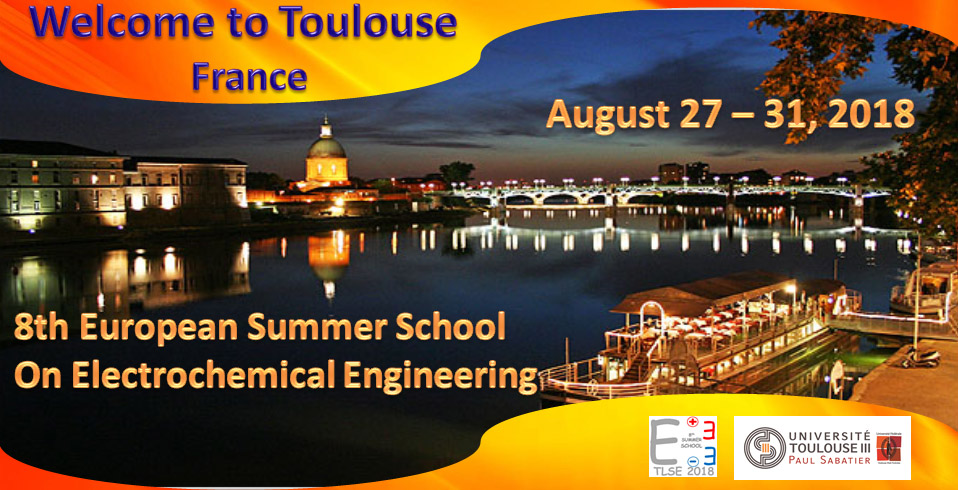
Programme par session
EFCE WP Electrochemical EngineeringSummer School Program, 27-31 August 2018Section 1: Electrochemistry-Basic elements Oxidation-Reduction, anode-cathode, polarities-spontaneous (or not) reactions, Double layers, electrode potential, Nernst equation, reference electrodes, electrolysis, examples of electrochemical processes Section 2: Electrochemical kinetics Butler-Volmer (BV) law (I=f(E)) and derived forms (Overpotential, kinetic parameters), BV approximations at high and low overpotential (linear equations, Tafel). Electrocatalysis applications. Section 3: Mass transfer Section 3a: Fundamental part Faraday Law, I-chemical rate-flux relation, molar flux expressions, mass transport modes, examples. Nernst simple-film model, Ist Fick s law, Simplified limiting current approach/ mixed control (kinetic + mass transport) /Derived form of the Butler-Volmer law-Applications (I=f(E), E1/2, analysis,.) Section 3b: Mass transport phenomena I -Migration flux, electrolyte conductivity, supporting electrolyte, mobility, transference number -Microscopic 'mass' and 'charge' balances, simplified forms and derived laws of: Ohm, Nernst-Planck, Laplace, Fick Section 3c: Mass transport phenomena II -Forced convection effects, laminar and turbulent flow, mass transport correlations, effects of gas bubbles. -Transfer in heterogeneous media (porous electrodes, polymeric organic and mineral membranes, conductive additives into the bulk) Section 4: Electrochemical reactor Section 4a: -design and operation Electrode materials and components for reactors building, divided/undivided cells, membranes and separators, monopolar/bipolar cells, three dimensional electrodes, gas diffusion electrodes. Fundamental relations: yields/conversion, cell voltage, power and energy consumption, investment costs vs running costs Section 4b: -mass balance Macroscopic mass balance for Batch, plug flow, CSTR, under potentiostatic, Galvanostatic and constant cell voltage modes. Specific set-ups (coupled tank, recycling) under galvanostatic conditions Section 4c: -Energetic (Enthalpic) balance. Current distribution (I, II, III). -Energetic (Enthalpic) balance for a CSTR under Galvanostatic operating mode. -Current distribution (I, II, III). Section 4d: - simulation (example: primary current distribution) Section 5: Energy Conversion and Storage Fundamentals; Primary/Secondary batteries, cell voltages, storage capacity-power/energy, Galvanic yield, cycling, Ragone diagram; Supercapacitors. Water & Steam Electrolysis; Power-to-gas; Fuel Cells; Redox Flow Cells; Photo-electrochemistry principles - Photo-electrochemical water splitting Section 6: Electro-deposition – Electro-machining Section 6a: Electro-plating/refining/winning in aqueous media Au, Cu, Ni, Zn, environmental and urban mining aspects. Thin layer and thick deposits, theory and practice. Section 6b: Electro-machining Simulation of some cases of industrial electrodepositions Section 6c: Electro-deposition (C- in molten salts) Al, carbides, nuclear, Section 7: Metal Corrosion and Protection Fundamentals and Applications Section 8: Electrosynthesis industrial processes chlor-alkali; chlorate; Water electrolysis for Hydrogen production Section 9: Electro-separations (coupling or not membrane) for preparative/analytical/ remediation purposes : (Electrodialysis, Electrophoresis, Electrocoagulation, Anodic electro-remediation of organics) Section 10: Bio-Electrochemical Processes Applications in sensing, corrosion, energy, remediation, synthesis, metal recovery... Section 11: Oral presentation of PhD students Workshop suggestions Synthesis- Conclusions- Closure
|

